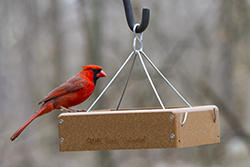 Fun Facts About Cardinals
Fun Facts About Cardinals
- Contrary to popular belief, cardinals prefer foraging on the ground instead of being perched high on feeders. One study in North Carolina revealed that Cardinals spent 77% of their time foraging on the ground.
- During the breeding season, male Cardinals may sing 200 or more songs per hour in the early morning hours. Mated pairs will often sing duets together.
- The Northern Cardinal is actually one of seven species in the world with the name Cardinal. Although it is a bird that historically called the Southern U.S. its home, the modifier Northern is appropriate because all of the other six species are located in South America.
- The Cardinal name was derived from the Cardinals (the rank above Bishop) of the Roman Catholic Church who wear red robes and hats.
- Young Northern Cardinals have black bills rather than the orange-red of the adults. It gradually changes to the adult color three to four months after hatching.
- The red color of the Cardinal’s feathers is the result of pigments called carotenoids. The amount of the pigment ingested, and then deposited in the feathers as they molt, influences the quality and depth of their coloration.
- Because Cardinals are mainly ground feeders, deep snow may severely affect their ability to feed. Winter-feeding probably helps Cardinals in their northern range to survive deep snow conditions.
- While birdfeeding may have played a small role in the northward expansion of the Cardinal’s range during the past 60 years, the steady increase in global temperatures during the last half of the 20th century is probably a more important factor. Studies show that the northern edge of the Cardinal’s range is limited to areas with an average January temperature of at least 5 degrees Fahrenheit. As this temperature gradient has moved north, so have the Cardinals.
- Another important factor in the Cardinal’s northward expansion is the change in land-use practices in the Northeast. The loss of the dense forest to agriculture and suburban uses has greatly expanded the amount of suitable habitat for Cardinals.
- The ability for Cardinals to digest food varies with the temperature; studies have shown that digestion efficiency rates are 16% higher at 77 degrees than at 32 degrees. This suggests that Cardinals must consume substantially more food during cold weather, especially when it’s below freezing.
- The food habits of Cardinals change during the year. A study has revealed that from November through April more than 75% of their diet consists of vegetable material; the month of July drops to a low of 35% vegetable material, while the remaining months vary between 50 to 70%. The availability of insects (beetles, grasshoppers, crickets) is the prime reason for this fluctuation.
- The size of the Cardinal’s breeding territory varies with habitat quality and population density, but generally ranges from two to ten acres.
- The oldest recaptured banded Northern Cardinal was still alive at 15 years and 9 months old.
- The Northern Cardinal is the state bird of seven states: Illinois, Indiana, Kentucky, North Carolina, Ohio, Virginia and West Virginia.
The Cardinals Favorite Foods!
- Safflower
- Premium Oil Sunflower
- Peanut Peices
- Suet

